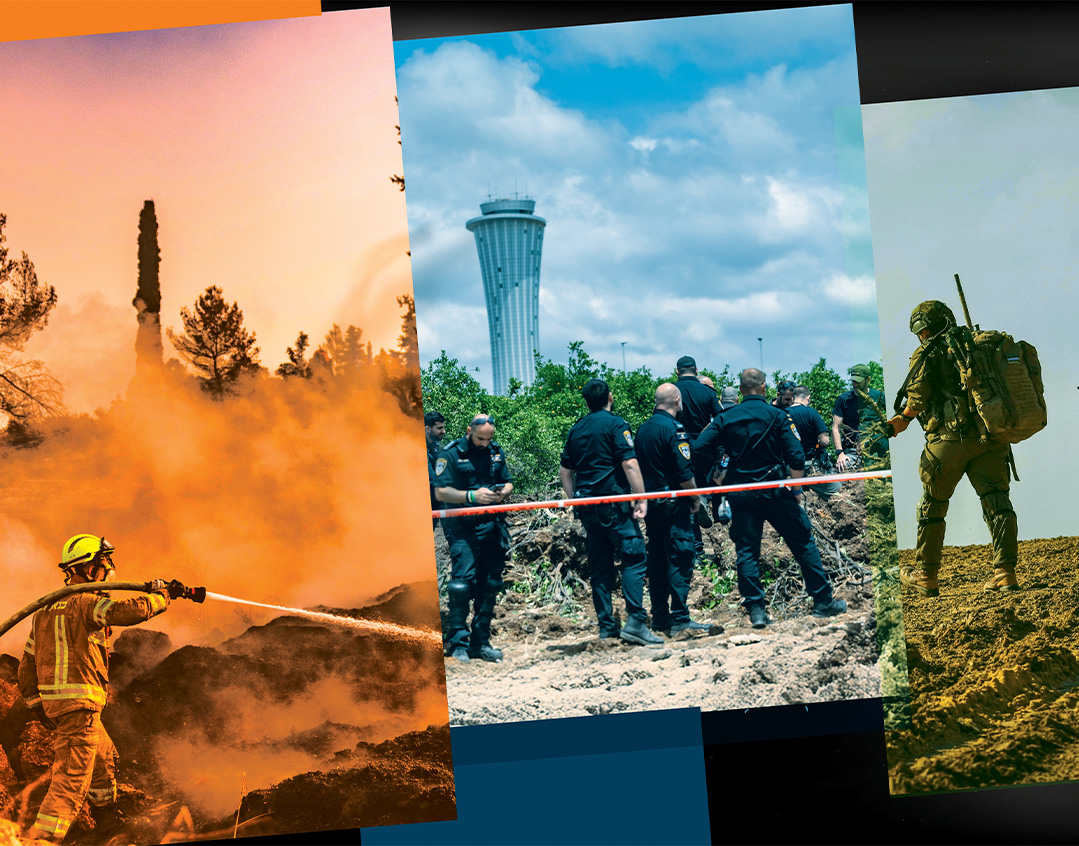Under Fire

After a year and a half of fighting, is Israel more entrenched than ever?

As swift, fierce, and alarmingly numerous fires erupted simultaneously in the dry forested hills between Jerusalem and Beit Shemesh, it was clear this wasn’t nature at work: It was an act of war.
As a gray mushroom cloud rose over Terminal 3, Iranian-backed Houthis managed to achieve what had been considered impossible: A ballistic missile launched from Yemen actually struck Israel’s international airport.
As the war in Gaza escalates to an advanced phase, where high-intensity operations are replacing previous strategies amid IDF plans to remain in the territories instead of pulling out and leaving a terror vacuum, Israel hopes to finally rid the Strip of Hamas.
After a year and a half of fighting, is Israel more entrenched than ever?
Photos
Flash90
Gearing Up in Gaza
The images of smoke rising from Rafah and the roar of explosions from the center of the strip are nothing new. But now, things are set to change. This Sunday, the Israeli security cabinet voted to approve a significant expansion of ground operations in Gaza, opening a critical new phase in a war that’s been going on for 19 months. The ramping-up of IDF efforts was likely behind last week’s Houthi missile attacks and, possibly, arsonists who set a series of wildfires in Israel.
“We’re focusing on two goals: one is to return our hostages, and the other is to defeat Hamas,” Prime Minister Binyamin Netanyahu announced in a video shortly before the cabinet vote. “There will be no Hamas in Gaza, everyone has to understand that.”
But his confident statement belied a stark disagreement between the political and military echelons behind the scenes — which could determine the fate of the dozens of Israeli hostages still held by Hamas.
The strategic plan approved by the cabinet includes three main stages: encirclement, evacuation, and long-term presence. In phase one, IDF forces will encircle key parts of the north and center of the Gaza Strip, completely cutting off traffic and supply routes. This will be achieved by deploying armored and engineering forces along strategic routes, as seen in Rafah.
The second phase will focus on the evacuation of the civilian population from those areas, through designated “humanitarian corridors.” Evacuation orders will be sent via leaflets, SMS messages, and radio and telephone broadcasts. According to the plan, each area will be declared a “closed military zone” after a 48-hour warning period, and civilians will be directed to designated humanitarian zones.
Three main humanitarian compounds are planned: one in the center of the Gaza Strip, in the area between Deir al-Balah and Khan Yunis; the second in the western area of Khan Yunis; and the third in the southern Gaza Strip. The complexes will be based on the model already established between the Morag and Philadelphi corridors, where hundreds of tents, food distribution points, and field clinics have been set up.
The third and most complex stage is the fighting to take long-term control in the evacuated areas. In contrast to previous operations in Gaza, this time the IDF plans to remain in the territories it conquers for an extended period. In these areas, the IDF will carry out in-depth searches of buildings and tunnels, mapping of underground infrastructure, and complete destruction of Hamas forces who remain in the area.
The searches will be carried out systematically, house by house, street by street, with a special emphasis on public institutions such as schools, mosques, and UN facilities, which, according to Israeli intelligence, often serve as centers of Hamas activity.
The effort will focus on the elimination of senior Hamas figures, the closure of shafts and tunnels, and the destruction of weapons depots. A senior security official explains: “Unlike previous actions, this time we’ll be staying on the ground for an extended period, to do a much more thorough job. This is no longer an ‘operation,’ but a new phase of the war.”
What sets this plan apart is its scope, geographically and in terms of time. The high-intensity operation is estimated to last many months, and will include at least three key parts of the strip, focusing first on the north — Jabaliya, Beit Hanoun, and Beit Lahia.
Twin Dilemmas
In
one of the sensitive security discussions over the past few weeks, IDF Chief of Staff Eyal Zamir issued a stark warning to Netanyahu and cabinet ministers: “Keep in mind that as part of an expanded operation, we could lose the hostages.”
Zamir also pointed to the potential contradiction between the two declared goals — defeating Hamas and returning the hostages.
Shin Bet chief Ronen Bar sided with the chief of staff, arguing that a less intense operation would allow a resumption of negotiations for a hostage deal. In response, some ministers countered that bringing the hostages back will be impossible without intensive military pressure on Hamas.
Ultimately, Netanyahu came down in favor of the plan: “It’s a good plan,” he said after examining the proposal presented to him by Zamir and Defense Minister Yisrael Katz.
“As long as Hamas continues to hold our hostages, we’ll continue to significantly expand operations,” said a senior Israeli official.
The chief of staff also warned of the humanitarian consequences of the extended fighting: “We won’t starve Gaza. Aid must come in soon.”
The tensions between the cabinet and the military echelon are also evident in the attitude toward humanitarian aid. Israel is emphasizing that the entry of aid into the Gaza Strip will be carried out in a much more measured manner than in the past, but the political echelon is still clinging to its refusal to allow any aid into Gaza.
In private conversations, Israeli officials acknowledge that “letting in 600 trucks a day was a mistake.” The new plan includes much tighter oversight of the aid, to prevent Hamas from taking it over. The distribution of food will occur through international companies and organizations, under indirect Israeli supervision.
Painful Costs
In the meantime, Israel is already beginning to pay the price. Hours before the cabinet convened, the IDF announced the death in Rafah of two Yahalom Unit fighters: Captain Noam Ravid, 23, from Shaarei Tikva; and Staff Sergeant Yali Seror, 20, from Omer. The incident occurred at 17:30 on Shabbos day as the soldiers searched a tunnel shaft inside a building in Rafah.
An initial IDF investigation provides a clearer picture of circumstances surrounding the tragic incident. Despite preliminary safety measures, an explosive device planted at the entrance to the shaft detonated. It’s believed that the charge was activated by a delay mechanism or a tripwire. Two soldiers were killed in the blast, and two others were evacuated to the hospital by helicopter, one in serious and the other in moderate condition.
The fighters were operating as part of a Golani Brigade force, under the command of the 36th Division, whose task was to encircle the Rafah area. The unit’s commanders noted that despite the progress in encircling Rafah, the enemy is still demonstrating combat capabilities, including the use of IEDs, anti-tank missiles, and attempts to approach the fence.
In another incident that day in the Daraj Tuffah area of the northern Gaza Strip, two other reserve soldiers of the 16th Brigade were wounded, apparently when a tank shell fired due to a malfunction (or alternatively, a mortar shell fired by terrorists) exploded. One was moderately wounded, and the other, who was lightly wounded, is already back in action. The details of the incident are still under investigation.
According to sources on the ground, Hamas’s tactics are based on concealment and ambush — they’re avoiding direct confrontation with IDF forces, instead hiding in tunnels and emerging for pinpoint attacks, firing anti-tank missiles or planting IEDs.
Another Call-Up
A
head of the expanded operation, Israel has begun a massive call-up of reservists. For some of the tens of thousands of reservists, it’s their sixth or seventh deployment of the war. A large portion will be deployed to Judea and Samaria, to free up regular forces designated for the Gaza operation.
What sets this call-up apart is the emphasis on combat engineers and underground warfare units. Units like Yahalom (the Special Operations Engineering Unit) and other special forces that specialize in tunnel warfare will be significantly reinforced. There is also a clear focus on soldiers with expertise in mapping and subterranean detection.
The use of the reserves poses a double challenge. On the one hand, the reservists bring to the table a great deal of combat experience accumulated during 19 months of fighting. On the other hand, fatigue and burnout are cumulative.
“We’re seeing the phenomenon of cumulative fatigue, but also a level of professionalism that we haven’t seen in the past,” said a senior source in the IDF’s Personnel Division.
The recruitment timetable is ambitious. Within 72 hours, tens of thousands of reservists are expected to show up, with some units already beginning to arrive at staging areas. The reserve units will undergo refresher training before they go into action, with an emphasis on urban and tunnel warfare.
At the same time, the Air Force has upped intelligence gathering and precision strikes. Dozens of targeted strikes on Hamas targets have been carried out over the past few days, to soften up the ground ahead of the ground maneuver.
“We’re talking about meticulous coordination between the forces on the ground, intelligence, and the Air Force,” explains a senior military official.
More Zbengim
In
the international arena, the reactions to Israel’s decision were largely predictable. The Trump administration has sent mixed messages: supporting Israel’s right to defend itself while voicing concern for the humanitarian consequences. At the same time, the Gulf states are exerting pressure on Hamas to soften its positions in the negotiations ahead of Trump’s expected visit to the region.
Qatar, which has in recent months has been largely absent from the negotiations, is coming back to the table, out of a desire to “secure a dividend from the president’s visit,” according to sources familiar with the matter. The country remains a key player and could have an outsized influence on developments in the coming days.
At the same time, the Gaza front can’t be seen in isolation from the other fronts. A vivid demonstration of this was provided by the Houthi missile strike on Ben-Gurion Airport, on the same day as the cabinet meeting.
Netanyahu addressed the incident in his video about the upcoming operation in Gaza: “We’ve attacked in the past, we’ll attack in the future. This won’t be a zbeng v’gamarnu [a single blow]. There will be more zbengim.”
Israel will likely have to strike in Yemen after the recent Houthi rocket launches.
The timing of the two events — the expansion of the fighting in Gaza and the Houthi missile strike — is hardly coincidental. Iran and its proxies coordinate their actions, and while Israel is preparing to expand the fighting in Gaza, the Houthis are trying to isolate Israel by attacking Ben-Gurion Airport and imposing an “air blockade.” Will they succeed? Israel’s response will give the answer.
Trial by Fire
By
Yaacov Lipszyc
On
the eve of Israel’s Independence Day, as fireworks were readied and flags fluttered from balconies and utility poles, a macabre spectacle ignited across the country. In dry forested hills and pastoral valleys, wildfires erupted — swift, fierce, and alarmingly numerous.
Within hours, fires had spread across the hills west of Jerusalem, in Park Canada and Neve Shalom, in Latrun and Mesilat Tzion, reaching as far as the outskirts of Ramat Beit Shemesh. Surreal scenes of drivers abandoning their vehicles en masse on Israel’s main highway went viral.
Although wildfires are sadly familiar to Israelis, here the timing, scope, and pattern were all wrong. This wasn’t nature at work. It looked more like war.
At press time, the fires — more than 200 in all — had consumed roughly 20,000 dunams of land, equivalent to nearly half the area of Tel Aviv. Firefighters, aided by the military and by aircraft from Greece, Croatia, and Italy, had brought the blazes under control after 33 grueling hours. No deaths were reported, though more than 20 firefighters were injured and 18 civilians hospitalized with smoke inhalation or minor burns. Nearly 10,000 residents were evacuated. The air still smells faintly of charred pine and ash settles on window ledges.
Yet even as embers cooled, questions flared. Were these fires accidental? Perhaps they were a consequence of Israel’s dry spring and unusually strong desert winds, with gales reaching up to 100 kilometers per hour. Or were they something more sinister, a domestic front in an increasingly multipronged military conflict stretching from Gaza to Tehran?
“Fires don’t start on their own,” said Yehonadav Lifshitz, spokesperson for Israel’s national fire and rescue service, in an interview with Mishpacha. “Sure, the wind and dryness helped them spread. But the ignition points — those were deliberate. Or at least caused by grave negligence. We can’t say more yet. The investigation is ongoing. It’s complex.”
Lifshitz was being careful, measured. But as images from security cameras in Judea and Samaria (the so called “West Bank”) emerged — grainy but unmistakable — showing figures moving through underbrush with lighters or Molotov cocktails, the narrative began to shift.
According to Lifshitz, “This happens every year around this time. Arabs trying to set fire to the land. We’ve seen it before.”
Inflaming Tensions
What’s different now is the context. In recent weeks, Israel has again found itself on a war footing. In Gaza, the IDF resumed incursions as rocket fire intensified. In Syria’s south, skirmishes have escalated between regime forces and rebel militias, with Israel caught in the strategic spillover defending the Druze. And on the Iranian front, a series of covert operations and cyberattacks have left Tehran rattled, with Israel widely suspected of involvement.
In this climate, the fires cannot be dismissed as seasonal mischief or random arson. They resemble acts of ecological terror — low-tech, low-cost, but highly effective psychological warfare.
Prime Minister Binyamin Netanyahu, speaking at a nationally televised Bible quiz ceremony — a yearly Independence Day tradition — sought to link the arson directly to broader hostilities.
“We have 18 people suspected of setting fires,” he announced. “Our neighbors, who claim to love this land, talk of burning the land. We love the land. We protect the land. And I am sure we will overcome this challenge too.”
But within hours, the police released a more modest count: just three confirmed arrests. The Shin Bet later added that two more suspects had been detained. The discrepancy exposed a familiar fissure — between political posturing and operational reality, between a leadership eager to project strength and security forces cautious not to inflame tensions further.
Still, the arrests and surveillance footage fueled speculation that the fires were coordinated. And whether or not the arson was centrally directed, it fit into a pattern of asymmetrical warfare that has increasingly defined conflict in the region.
One positive that made international headlines was the swift arrival of foreign assistance to help contain the fires. Support came from across Europe — Britain, Sweden, Greece, Italy, Bulgaria, nations familiar with wildfire season, yet quick to respond to Israel’s call. Three firefighting aircraft, dispatched from Croatia and Italy, joined the effort, their arrival prompting a public debate: Does Israel truly possess the capacity to manage such disasters on its own?
“Israel is absolutely equipped to handle these situations,” insisted Yehonadav Lifshitz, the fire service spokesman. “If I’m not mistaken, we have the highest number of firefighting aircraft per capita in the world. Ever since the Carmel disaster, the government has understood the need to strengthen our aerial firefighting force. Today, it’s probably among the best anywhere.”
Lifshitz explained that between 12 and 14 firefighting planes, alongside several helicopters, were deployed. “The foreign aircraft were helpful,” he said. “They operate a bit differently in terms of water loading systems, but they integrated well with our units. They came to assist — and they did.”
Smelling the Loss
The Carmel fire is an unavoidable point of comparison. That tragedy, which claimed 44 lives and destroyed 50,000 dunams, remains seared into the national memory. But it also sparked reform: new equipment, better training, and more coordinated responses between fire services, police, and the military. This time, those investments seemed to pay off. No lives were lost. Damage, while substantial, was limited. Still, the public was left shaken — and not just by smoke.
The symbolic cost may yet prove greater than the material one. Independence Day events were canceled or scaled back in many areas. The usual jubilance was replaced by unease. A country accustomed to existential threats from without now faced them within its own forests.
And those forests, too, carry their own symbolism. Israel’s reforestation efforts, led for decades by the Jewish National Fund, have transformed arid hillsides into green sanctuaries — a kind of national Eden, lovingly planted and fiercely protected. To see them burn, to smell their loss in the air, is to feel the fragility of what has been built.
No official estimate of damages has been released, though it is expected to run into the tens of millions of shekels. Insurance claims and compensation frameworks remain under discussion. For now, the focus remains on prevention and deterrence. Surveillance is being stepped up in the West Bank, and intelligence services are monitoring online chatter for signs of incitement.
Indeed, for those unable to confront Israel militarily, arson offers a cruel workaround. It erodes a sense of safety. It sows suspicion. And it casts doubt, however briefly, on the state’s ability to protect its own soil.
As tensions continue to escalate — from the deserts of Syria to the alleys of Rafah, from missile alerts near Ben-Gurion Airport to the olive groves of Judea and Samaria — Israelis are once again being reminded that the land they love, and fight for, can be scorched not only by rockets, but also by simple cigarette lighters.
Unhappy Landing
By
Kobi Borenstein
The dramatic footage from Ben-Gurion Airport said it all: a gray mushroom cloud rising above Terminal 3, people running for cover, and in the background, shouts in Arabic: “Ya waradi! [“Watch out!]”
At 9:22 on Sunday morning, sirens wailed across the Dan region, the Shfela, Samaria, and even Jerusalem. About three tense minutes passed before the explosion was heard. The blast wave caused a tremor felt for kilometers around.
The Houthis, an Iran-backed rebel group from Yemen, managed to achieve what had been considered impossible: launching a ballistic missile from over 1,800 kilometers to strike Israel’s international airport.
It wasn’t their first attempt. Since fighting resumed in Gaza on March 18, following the collapse of a ceasefire, the Houthis had launched 27 ballistic missiles toward Israel, all of them successfully intercepted. Until now.
“Everything shook, small stones and clumps of dirt flew into the air from the impact site,” said Dvir, a traveler who was nearby. “I was at the Ben-Gurion Airport exit, over a kilometer away from the impact, and it still felt like it happened right here.”
What began as a routine day quickly turned into chaos. According to Magen David Adom, five people were injured: a man in his fifties was moderately to lightly hurt with limb injuries; two women, aged 54 and 38, suffered mild injuries from the blast; a 64-year-old man was lightly hurt by a flying object; and a 22-year-old woman was mildly injured on her way to a shelter. Two other passengers were treated at the scene for shock.
The physical damage was limited — the missile, or a part of it, landed in an open orchard near Terminal 3, leaving a blackened crater. But the strategic damage began unfolding immediately. Within hours of the incident, around 20 international airlines announced suspensions of flights to Israel for up to 72 hours. Later that day, that number rose significantly. The threat —not only to Israel’s security but also to its global connectivity — became tangible.
The strike on Ben-Gurion Airport is not just a security event. It is a strategic incident with long-term implications. Ben-Gurion is Israel’s primary gateway to the world. In times of war, it is also a critical lifeline for military supply deliveries. The fact that an actor thousands of kilometers away could threaten the airport’s normal operations presents a clear strategic danger.
During the Yom Kippur War, the Gulf War, and various confrontations with Hezbollah and Hamas, the country managed to keep Ben-Gurion Airport functioning. This strike marks a dangerous new threshold in regional escalation. It’s not the first time airlines have been hesitant to fly to Israel out of concern for airport safety — but it is the first time the threat has felt so real.
Fumbling the Interception
Ten seconds after the explosion, chaos erupted in the Air Force’s missile interception command center. The warning systems had accurately predicted the missile’s trajectory, and the defense systems responded exactly as rehearsed. But something had gone wrong.
According to the IDF spokesperson, an initial inquiry revealed a troubling finding: “It was likely a localized technical failure in the interceptor launched at the missile.”
There was no failure in the detection process or in the operation of the warning and interception systems — simply put, the interceptor did not function as intended.
The full story is more complex. According to senior sources, an interceptor from Israel’s Arrow missile defense system was initially launched — but it missed the target. Immediately after, a second layer of defense was activated with an interceptor from the American THAAD system deployed in Israel — but it also missed.
This wasn’t supposed to happen. The Arrow system is a point of national pride, with a success rate of over 95% for intercepts since the war began. The American THAAD system is considered one of the most advanced missile defense systems in the world. The odds of both systems failing against the same target are extremely low — but that’s exactly what happened.
“Interception is optimal during the acceleration phase, when the missile is still above the launch country or over intermediate regions,” explained a senior military source familiar with the systems.
The problem: Israel cannot intercept a Houthi missile while it’s still over Yemen or the Gulf states. When the interception takes place only in the final phase, over Israeli airspace, the margin for error shrinks dramatically.
The big question: Was this a one-off failure, or does it reflect a broader capability gap? Arab media boasted that the missile launched by the Houthis was “a new missile capable of bypassing radar.” The group’s spokesperson, Yahya Saree, went as far as to claim it was a “hypersonic ballistic missile” — a highly advanced technology that combines extreme speed with maneuverability.
Israeli defense officials categorically reject these claims. “There is nothing special about this missile,” said a source in the air defense command. “We’ve successfully intercepted dozens just like it.”
His proof: Unlike with previous launches, this time the Houthis didn’t name the missile type — indicating it’s not some technological breakthrough.
Still, the very fact that it hit its target raises serious questions. A ballistic missile of this type, moving at several kilometers per second and carrying hundreds of kilograms of explosives, is a deadly threat.
“When something the weight of a small car hits at that speed, the result is total devastation,” the military source explained.
The only stroke of luck: The missile struck a relatively open area, and not the crowded terminal or an aircraft on the runway.
How could this happen? Israel’s multi-layered missile defense system is among the most advanced in the world.
Iron Dome (short-range), David’s Sling (medium-range), and for long-range ballistic missiles — like those used by the Houthis — Israel uses its top layers: Arrow 2 and Arrow 3, with ranges from hundreds to thousands of kilometers. An Arrow 2 interceptor costs about $1.5 million per launch; Arrow 3 is estimated at $2 million. By comparison, Iron Dome intercepts cost about $30,000 each.
The Americans bolstered this system with the THAAD battery, also designed to intercept ballistic missiles. But even the best systems aren’t error-proof. Ballistic missiles from Yemen reach their terminal velocity within about 15 minutes and travel at extreme speeds. Any small calculation error, misguidance, or mechanical malfunction in the interceptor itself can lead to failure.
Israel, which had prided itself on a greater than 95% interception success rate, now faces reality: There is no such thing as hermetic defense.
Aerial Blockade
The Houthi threat did not arise overnight. Since the outbreak of war in October 2023, the Yemeni rebel group has tried to insert itself into the regional equation. Initially, they used drones and cruise missiles against vessels in the Red Sea, claiming they were preventing goods from reaching Israel. Later, they began launching ballistic missiles directly at Israeli territory.
So far, the conflict has been limited. The US and UK have taken the lead in battling the Houthis. In recent months, the US has carried out hundreds of airstrikes in Yemen against the rebels, killing hundreds and destroying key terror infrastructure. Israel, for its part, has refrained from striking in Yemen (aside from five limited operations), largely at the request of the United States.
The strike on Ben-Gurion Airport changed the equation.
Senior Houthi official Mohammed al-Bukhaiti told Qatar’s Al-Araby channel with rare bluntness: “We’ve proven our ability to strike the military prestige of the US, Britain, and Israel. There are no red lines in our confrontation with the Zionist entity, the US, and Britain. The strike on Ben-Gurion is proof of our ability to hit fortified sites within Israel.”
But the more concrete threat came from Houthi military spokesman Yahya Saree, who declared: “We again warn international airlines against continuing flights to Ben-Gurion Airport, which is not safe.” Later, he expanded the warning: “In response to Israel’s escalation and announcement of expanded aggression in Gaza, the Yemeni armed forces declare they will work to impose a full aerial blockade on the Israeli enemy by attacking airports in Israel.”
Their strategy is clear: Isolate Israel from the world. Ben-Gurion Airport is Israel’s main gateway, handling around 90% of international passenger and cargo traffic. Hitting this target means severing one of the state’s lifelines.
And now, the threat is materializing. About 20 international airlines — some major ones from Europe, the US, and Asia — canceled their flights to Israel for at least 72 hours. Transport Minister Miri Regev stated that “thirty foreign airlines are still operating normally at Ben-Gurion alongside the three Israeli airlines,” but she also instructed preparations “for a scenario in which foreign carriers do not return after the 72 hours.”
The economic implications are massive. Tourism to Israel, which had just started recovering after the October 2023 war, will take another severe blow. Exporters and importers will face increased costs and delays. As for Israelis hoping to travel abroad — the prices on the few remaining airlines are expected to soar.
And the security consequences are even more alarming. In a scenario of further escalation and international airlines avoiding Israel, only Israeli carriers — El Al, Arkia, and Israir — can maintain air links to the world. And in the event of full-scale war, even they may be limited.
The aerial blockade the Houthis threaten is shifting from a theoretical threat to an emerging reality. This is one of the most strategic weapons a terror group can wield against Israel — without engaging in a direct, full-blown war. —
(Originally featured in Mishpacha, Issue 1060)
Oops! We could not locate your form.







